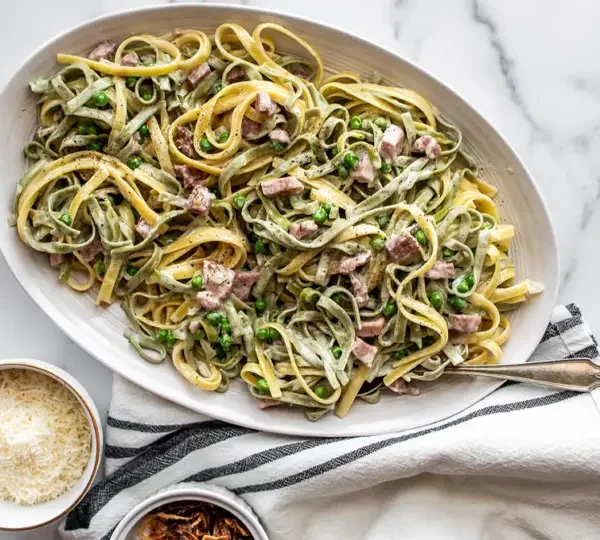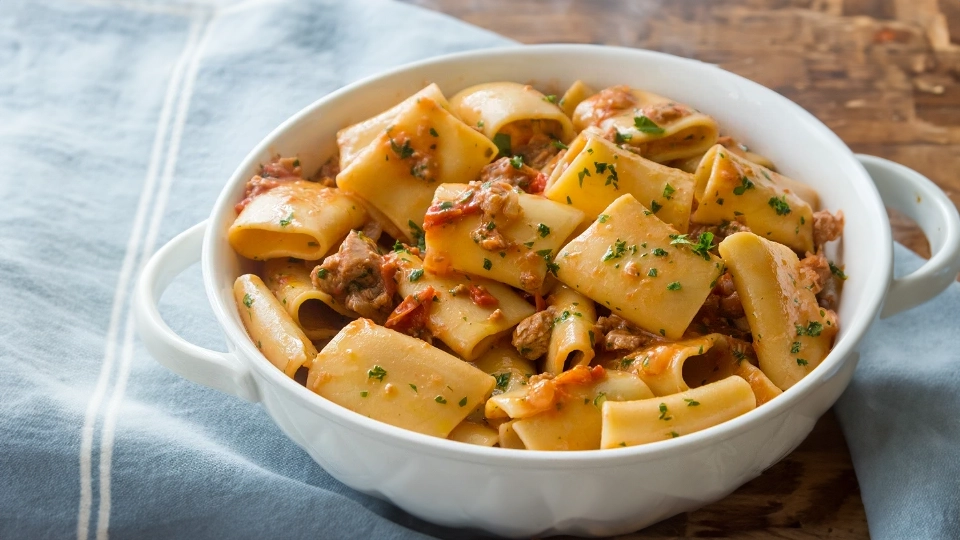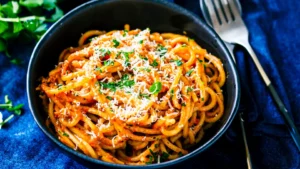Italian cuisine is a blend of simplicity and depth, where each dish narrates a tale of tradition, affection, and exquisite flavors. Within this flavorful mosaic, straw and hay tagliatelle emerges as a tribute to the graceful texture and harmonious colors that define Italian gastronomy. Embark on a culinary journey with me to uncover the mysteries of this delightful pasta, harmonizing the two subtle yet refined flavors of golden straw and lush hay.

Through this blog, my aim is to awaken the culinary artist in you as we craft a plate of pasta that transcends mere sustenance, evolving into a culinary masterpiece.
Straw and Hay Tagliatelle

Ingredients
Before we start rolling, we need to gather the essentials for our tagliatelle. Here’s what we’ll need:
For the Straw Tagliatelle:
- 200 grams of Spinach (fresh or frozen)
- 2 cups of ’00’ grade Flour
- 2 large Eggs
The straw tagliatelle infuses the pasta with the delicate taste of spinach and the striking green hue, making it the perfect palette to pair with your favorite light sauces.
For the Hay Tagliatelle:
- 2 cups of ’00’ grade Flour
- 1 teaspoon of Turmeric (for color)
- 2 large Eggs
The hay tagliatelle mirrors the color of golden fields, adding a sunny disposition to your pasta bowl. In its simplicity, this version of tagliatelle is splendid when coated with luxurious, thick sauces.
The magic weaves through the dough as we combine the bold yellow of turmeric with the earthy ’00’ grade flour, the cavernous eggs creating a pastel array that will emerge as two distinct types of tagliatelle.
Instructions
Now that we have our ingredients in place, it’s time to roll up our sleeves. The preparation of tagliatelle is a process that requires patience and precision, for each strand represents the artistry of Italian pasta-making.
Preparing the Dough:
- For the straw tagliatelle, start by blanching the spinach and then pureeing the leaves to extract the vivid green essence.
- Taking a well of flour, make a pool in the center and break in the eggs. For the straw tagliatelle, also include the spinach puree.
- Begin to whisk the eggs with a fork, slowly incorporating the flour. Keep going until a dough starts to form.
- Continue kneading until the dough is smooth and elastic. This will take around 10 minutes. Then wrap it in cling film and allow it to rest for at least 30 minutes.
- For the hay tagliatelle, the process is similar, but you will add the turmeric to the flour before making the well for the eggs.
The dough here is a living, breathing thing. It needs to be cared for, nurtured, and allowed to rest, so that the pasta-making process captures the essence and effort put into it.
Rolling and Cutting the Tagliatelle:
- After resting, our pasta dough is ready to be transformed. Start by rolling it out on a clean, floured surface. You will want it to be quite thin, so it lets the light and sauces through.
- With a sharp knife or pasta cutter, slice the dough into ribbons about a quarter of an inch wide for the hay tagliatelle and a little thicker for the straw tagliatelle.
- Dust the tagliatelle with flour to keep them from sticking together and then you can either cook them immediately or allow them to dry.
When you slice that dough, you’re not just creating ribbons, you’re also cutting through dimensions of flavor and artistry. Each tagliatelle will be as unique as a snowflake, imbued with its own character.
Cooking the Tagliatelle:
- Bring a large pot of well-salted water to the boil.
- Add your tagliatelle and cook for 2-3 minutes, or until al dente.
- To test, fish one out and give it a taste. It should have a slight bite to it.
Once that pasta hits the water, it awakens. It stretches and dances, taking form, and becoming part of a timeless tradition of taste.

DID YOU MAKE THIS RECIPE?
Tag @amcookingitaliano on Instagram and hashtag it #amcookingitaliano!
Tips for Customization
The beauty of Italian cuisine is in its versatility. While the traditional tagliatelle recipes are culinary marvels, they can also serve as canvases for your personal taste. Here are a few ways you can customize your tagliatelle and make it truly your own:
- Sauces: The delicate and springy straw tagliatelle pairs beautifully with light and creamy sauces, while the chewy and robust hay tagliatelle craves heartier, meaty sauces.
- Flavor Infusions: Don’t be afraid to play with flavors. Add freshly cracked black pepper for a punch of heat, or toss in some sautéed mushrooms for an earthy undertone.
- Garnishes: A sprinkling of freshly grated Parmesan cheese, a few basil leaves, or a drizzle of truffle oil can take your tagliatelle to new heights of taste.
By adapting these elements, you can create a tagliatelle that is as versatile as it is divine, tailored to your taste and the mood of the moment.
How to Store
Sometimes, the moment isn’t right to savor your homemade tagliatelle. Fear not, for these strands can be preserved with care, like a valuable jewel in the crown of culinary creations.
Once cut, the tagliatelle can be laid out in nests or straight lines on a floured tray and allowed to dry completely. This can take a few hours, depending on the humidity. Once dry, they can be kept in an airtight container and stored in a cool, dark place for up to a month. If they are still slightly damp, you can also freeze them on a tray and transfer to a sealed bag once they are solid.
When you’re ready to eat, just drop them directly into boiling water from their frozen or dry state. It might take a few extra seconds for the water to come back to a boil, but the wait is worth it for fresh-made pasta that feels like a hug from an Italian nonna.
Conclusion
Italian straw and hay tagliatelle isn’t just about eating; it’s about experiencing. It’s a culinary cruise through the landscapes and traditions of one of the world’s most praised cuisines. With each step we’ve taken, from the hues of the turmeric and spinach to the cutting of the ribbons, we’ve embraced the soul of pasta-making. A dash of diligence, a dollop of love, and a sprinkle of skill combine to create a dish that is as personal as it is cultural.
The next time you’re craving a taste of Italy, don’t just reach for the sauce and the cheese—dive into the dough, the rolling, and the cutting. And remember, the true essence of Italian cooking lies not in the pantry, but in the hands of the cook. Buon Appetito!
FAQs
What is the meaning of “straw and hay” in the context of tagliatelle?
The terms “straw” and “hay” in relation to tagliatelle refer to the color and texture of the two pasta types. Straw tagliatelle is colored with spinach and has a green hue, resembling straw. Hay tagliatelle is influenced by turmeric and has a golden color, similar to dried hay.
Can I make tagliatelle without a pasta machine?
Yes, you can make tagliatelle without a pasta machine by rolling the dough by hand and cutting it into ribbons with a sharp knife or a pasta cutter. It may take a bit more effort, but it’s entirely possible to make excellent pasta by hand.
What dishes pair well with Italian straw and hay tagliatelle?
Straw and hay tagliatelle pairs beautifully with lighter sauces like a simple butter and sage or a creamy mushroom. Hay tagliatelle can stand up to richer, meatier sauces such as Bolognese or a hearty ragù. Both types also work well with seafood and light, fresh sauces with a touch of lemon or white wine.
















